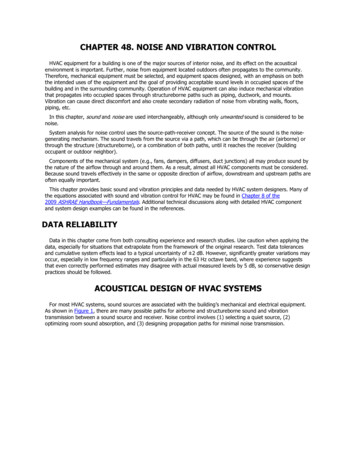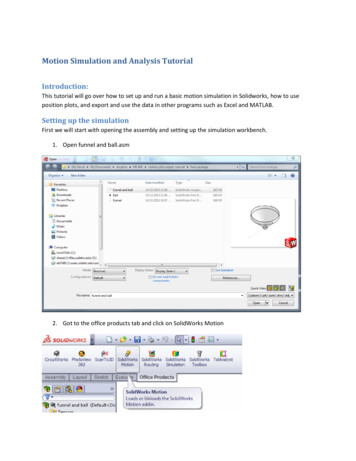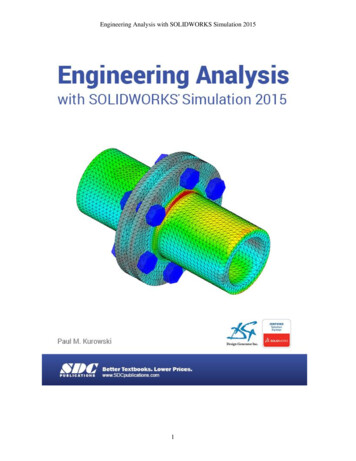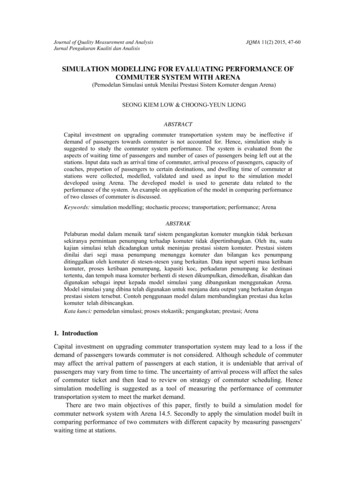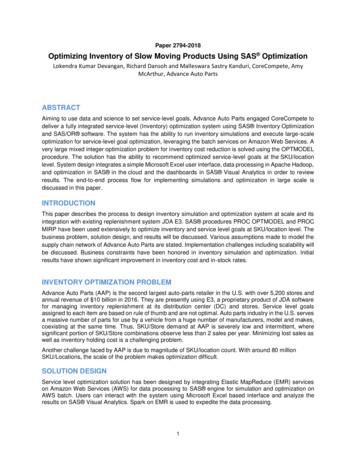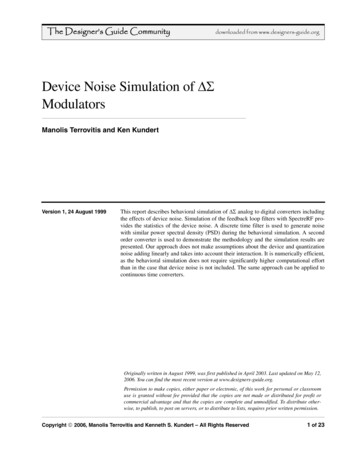
Transcription
The Designer’s Guide Communitydownloaded from www.designers-guide.orgDevice Noise Simulation of ΔΣModulatorsManolis Terrovitis and Ken KundertVersion 1, 24 August 1999This report describes behavioral simulation of ΔΣ analog to digital converters includingthe effects of device noise. Simulation of the feedback loop filters with SpectreRF provides the statistics of the device noise. A discrete time filter is used to generate noisewith similar power spectral density (PSD) during the behavioral simulation. A secondorder converter is used to demonstrate the methodology and the simulation results arepresented. Our approach does not make assumptions about the device and quantizationnoise adding linearly and takes into account their interaction. It is numerically efficient,as the behavioral simulation does not require significantly higher computational effortthan in the case that device noise is not included. The same approach can be applied tocontinuous time converters.Originally written in August 1999, was first published in April 2003. Last updated on May 12,2006. You can find the most recent version at www.designers-guide.org.Permission to make copies, either paper or electronic, of this work for personal or classroomuse is granted without fee provided that the copies are not made or distributed for profit orcommercial advantage and that the copies are complete and unmodified. To distribute otherwise, to publish, to post on servers, or to distribute to lists, requires prior written permission.Copyright 2006, Manolis Terrovitis and Kenneth S. Kundert – All Rights Reserved1 of 23
Device Noise Simulation of ΔΣ ModulatorsIntroduction1 IntroductionDelta-Sigma (ΔΣ) data converters are widely used, particularly in applications wherehigh precision is required and the signal band is relatively small, such as in the processing of audio and sensor signals. They are inherently insensitive to process imperfectionssuch as component mismatch and they can be easily integrated in inexpensive CMOStechnologies. Receiver architectures that employ band-pass ΔΣ A/D converters toreplace part of the analog RF part have been proposed [4, 5].Because ΔΣ converters are large mixed-signal circuits and their performance characterization requires extremely long transient simulations, transistor level simulation isimpractical because of time limitations. Behavioral simulation is used instead to test thefunctionality of a design. The behavioral models of the building blocks can include second-order effects such as finite opamp gain, finite opamp slew rate, component mismatch and nonlinearities [13]. It is the subject of this study to include device noise in thebehavioral models.Although device noise is often a limiting factor in the performance of ΔΣ data converters, it is not usually taken into account in simulations. Simulating noise with a circuitsimulator at the transistor level is impractical as explained above. In addition, circuitsimulators that are capable of providing the noise PSD at the output of circuits with atime-varying operating point, such as the Cadence analog simulator Spectre RF†,require a periodically changing operating point. The operating point of ΔΣ converters ingeneral changes in a non-periodic fashion even for a DC input [1].In this report we describe the device noise characterization of the building blocks of theconverter, and the subsequent behavioral simulation. To demonstrate the proposed methodology, we use a discrete time second-order ΔΣ converter as an example. The SpectreRF analog simulator is used for characterization of the building blocks. Whencompared with the usual behavioral simulation of ΔΣ converters, the proposed methodology does not require more timesteps and does not significantly increase the computational effort. This is a significant advantage compared to other suggested approaches[12]. Because of the multitude of architectures used in ΔΣ converters, the designer willprobably need to modify the presented methodology to fit its own needs.2 ΔΣ AD Converter BackgroundThe block diagram of a ΔΣ analog-to-digital converter is shown in Figure 1. It is a feedback loop that employs filters, an Analog-to-Digital Converter (ADC) and a Digital-toAnalog Converter (DAC). The resolution of the ADC and DAC is much lower than thatof the ΔΣ converter. Often the ADC is a comparator and the DAC converter has only twooutput levels. Digital values are produced at the output of the ADC at a much higher ratethan the signal bandwidth. The ΔΣ converters are oversampling converters, whichmeans that the quantization noise power is spread over the wide sampling frequencyrange and only a small part of it falls in the signal band. The ratio of the sampling frequency over the Nyquist rate is called the oversampling ratio. The quantization noise inthe signal band is further suppressed by the loop gain. The operation of the converter†. Spectre is a registered trademark of Cadence Design Systems.2 of 23The Designer’s Guide Communitywww.designers-guide.org
ΔΣ AD Converter BackgroundDevice Noise Simulation of ΔΣ Modulatorscan be better understood from the linear loop model of Figure 2 in which the quantizerformed by the ADC and DAC of Figure 1 have been replaced by a source of quantization error en. The representation of Figure 2 is accurate, but one must be aware of thefact that the quantization error en is not an independent input, but completely determined by the input signal. Under conditions of busy input signal the quantization errorvalues resemble uncorrelated samples with a flat frequency spectrum, and the quantization error source resembles an independent white noise source. The loop filters are suchthat the transfer function of the input signal xn to the output yn in the signal band is aconstant, while the transfer function from the quantization noise source en to the outputyn is ideally zero. In reality, the quantization error is not white but it contains periodicpatterns that give rise to tones, or spikes in the frequency spectrum. These spikes contain high energy and deteriorate the performance of the converter if they fall in the signal band. Strong quantization noise tones can be detrimental even if they are out ofband, since they can leak into the signal band through intermodulation distortion, ormixing with a parasitically coupled strong clock signal [1].FIGURE 1 A ΔΣ analog-to-digital converter.xnyn F(z)ADCDigital filter &Decimator-G(z)DACQuantizerFIGURE 2 The linearized model of a ΔΣ analog to digital converter.Quantizationerrorenxnyn F(z) Digital filter &Decimator-G(z)The loop filters are often discrete time switched capacitor filters, but they can also becontinuous time active or passive filters, in which case the converter is called continuoustime. In a baseband converter, the loop transfer function is an integrator or another lowpass filter, while in a bandpass converter the filter is a resonator.To randomize the quantization error and avoid the generated tones, a pseudorandom signal is often added at the input of the quantizer. This technique is known as dithering [1].It is known that the device noise also has a dithering effect, but in most cases inadequateto effectively remove completely the undesired tones [1].The Designer’s Guide Communitywww.designers-guide.org3 of 23
Device Noise Simulation of ΔΣ ModulatorsMethodologyThe order of the delta-sigma converter is defined as the order of the loop transfer function. The higher the order the better the noise suppression, but usually designs of orderhigher than two are prone to instability. An alternative that effectively implementshigher order noise suppression is the cascaded, or multistage, or MASH (MultistageNoise Shaping), converters. In these, the quantization error of a low order converter isprocessed as an input to another ΔΣ converter. Digital logic combines the outputs of allstages to one output, and ideally the resulting conversion is equivalent to that of a singlestage converter of order equal to the sum of the orders of all individual stages. The proposed methodology can be used for discrete or continuous time converters, and can beadapted for cascaded converters. If dithering is employed it can be simulated simultaneously with the device noise.3 MethodologyThe analog circuitry of a ΔΣ converter contributes device noise, which together with thequantization noise, contaminates the output. In cases where in the signal band one of thetwo sources of noise is much lower than the other, the weak one can be neglected. If thequantization error is dominant, its effect can be simulated in the behavioral level as iscommonly done with Midas [14], Matlab, a programming language such as c, or Verilog-A [7,15]. If the quantization noise is very low in the signal band as in cases wherethe oversampling ratio is very high and there are not tones of accumulated energy, itseffect can be neglected, and the in-band device noise alone suffices to be considered. Ifit is known that the quantization error truly resembles white noise and that the linearmodel of Figure 2 holds, the output device and quantization noise can be found separately as if the other source were not present, and then added to obtain the total outputnoise.In the general case however both sources of error are present and the device noiseaffects the quantization noise. In particular, if one source of noise is negligible, designresources have probably been wasted. In wideband applications, the oversampling ratiocannot be very high and the quantization noise cannot be arbitrarily low. The out-ofband device noise indirectly has an effect on the performance because it affects the inband quantization noise.Since the digital filter reads periodically the ADC output and the signal fed backthrough the DAC must be exactly what the digital filter reads, the ADC must be clockedwith latched output, in both discrete and continuous time ΔΣ converters. Therefore, thedevice noise that the analog circuitry generates can be represented by a discrete timenoise process injected at the input of the ADC. With the proposed methodology thecombined effect of the device and quantization noise can be estimated. It can be summarized in the following steps4 of 23 The noise performance of the analog circuits involved in the loop is characterizedand the PSD of the equivalent discrete time noise process at the quantizer input isdetermined. A discrete time filter is found, which when fed with white noise, generates noisewith PSD similar to that of the equivalent noise. Time domain behavioral simulation with a representative input signal is run, similarly to how it is done for quantization noise effects in [13, 14]. In addition, noisegenerated by the discrete time filter is injected at the input of the ADC. The freThe Designer’s Guide Communitywww.designers-guide.org
Device Noise Simulation of ΔΣ ModulatorsDevice Noise Estimationquency spectrum of the time domain output reveals the quality of the data conversion. The behavioral models used for the building blocks can be otherwise ideal, orthey can include other nonidealities, as described in [13]. Dithering can also bepresent in the simulation.4 Device Noise EstimationA necessary assumption in the noise characterization of the analog part is that the generated device noise is independent of the input signal and the ADC output, which is ingeneral a non-periodic signal. The assumption that the generated noise is independent ofthe input signal is usually made in the characterization of switched capacitor and continuous time active filters, similar to those used in discrete and continuous time ΔΣ converters respectively. It is usually accurate and it will be discussed in detail for theexample circuit of Section 5 on page 8.Let us consider first discrete time ΔΣ converters. The operating point of the devices inthe switched capacitor filter changes wildly during the clock period. Assuming as wementioned above that the generated device noise is independent of the processed signal,noise at the input of the ADC is a continuous time cyclostationary process u(t) with PSDSu(f, t). Let t0 denote the time instant within the clock period at which this process issampled by the ADC, and ud(nTs ) denote the resulting discrete-time noise process. It isintuitive and also easy to show that sampling a cyclostationary process once in a periodresults in a stationary discrete time process. The PSD of ud(nTs ) is† Su ( f ) d S u(f – kf s, t 0)(1)k – The Cadence analog simulator SpectreRF is capable of accurately predicting the noiseperformance of switched capacitor circuits [8, 9]. It is a continuous time simulator andprovides the time average noise PSD. To extract S u ( f ) , an ideal sample and hold cirdcuit (S/H) can be employed, which samples the noise process u(t) at time t0 and holdsthis value for a whole period.‡ Let us denote the piecewise constant output of the S/Hcircuit with ush(t). It can be easily shown that this is a cyclostationary process and thetime average of its PSD S u ( f ) is related with the PSD of ud(n) bysh†. We are using here the following definition for S u ( f )d Su ( f ) Tsd R u (kT s)e– j k2πT s fdk – where R u (kT s) is the autocorrelation function of ud(nTs ). If it is desirable to find the power ofdud(nTs ) one should integrate S u ( f ) as given by the following equations from 0 to fs/2, if thedPSD Su( f, t) of the continuous time processes on the other side of the equation is single sided,or from 0 to fs if it is double sided. SpectreRF provides single-sided PSDs.The Designer’s Guide Communitywww.designers-guide.org5 of 23
Device Noise Simulation of ΔΣ ModulatorsDevice Noise Estimationsin ( πfT s ) 2S u ( f ) ----------------------- S u ( f ) πfT s shd(2)We intend to perform time domain behavioral simulation, during which the feedbackloop will be closed through the quantizer, and ud(n) is the noise signal that we intend toadd at the quantizer input. Therefore, during the simulation of the switched capacitor filter with SpectreRF that will provide ud(nTs), the loop filter must be open as shown inFigure 3. Alternatively instead of injecting a noise signal in front of the quantizer wecan inject at the input a noise signal w(n) with PSD1S w( f ) ----------------- S u ( f ) .2 dF( f )(3)FIGURE 3 The feedback loop open. The input of filter G(z) is zero. The noise process u(t) is the output noiseat point B, while w(t) is the noise referred to point A.BA F(z)-G(z)It is easy to see that the input referred noise of an open loop system is identical to theinput referred noise of the closed loop system and therefore Sw( f ) can be also be calculated from the closed loop system of Figure 4. This is useful because, as we will see inthe example of the next section, in some cases it is easier to simulate a closed loop system rather than the corresponding open loop.† In addition, SpectreRF provides directlythe PSD of the discrete-time input-referred noise, and one does not need to compensate2for the term ( sin ( πfT s ) ( πfT s ) ) as in (2). Let us denote the closed-loop output noiseby v(t), its sampled version by vd(n), and the output of the corresponding S/H circuitused in simulation by vsh(t). Similarly to (2)sin ( πfT s ) 2S v ( f ) ----------------------- S v ( f ) , πfT s shd(4)‡. Such an ideal sample and hold circuit is described by Kundert [6] and consists of a samplingcapacitor in series with a time varying resistor. It does not represent a load for the sampled circuit, it has infinite driving capability and its time constant during the sampling phase can bearbitrarily small. The sampling instant is given with the delay parameter, and in our applicationthe aperture must be much smaller than the period (such as 1/100th), and the time constant tcabout 10 times smaller than the aperture.†. When a simulation for the input-referred noise of a switched capacitor circuit is performed, itis advisable that an additional ideal S/H is used at the input, sampling the input signal anytimeoutside the sampling phase of the actual input S/H of the circuit, implemented with realswitches. This is because the actual S/H may have adequate bandwidth for a baseband signal,but not for one close to fs/2. The ideal S/H freezes the input signal and the actual S/H hasenough time to settle. The input referred noise simulated in this way can then be used with theideal transfer function in the behavioral simulation, to provide the correct output noise at allfrequencies.6 of 23The Designer’s Guide Communitywww.designers-guide.org
Device Noise Simulation of ΔΣ ModulatorsDevice Noise Estimationwhere S v ( f ) and S v ( f ) are the time average of the PSD of vsh(t) and the PSD of vd(n)shdrespectively. Assume that closed loop system implements the discrete time transferfunction H( f ). In order to calculate the input referred noise, SpectreRF divides S v ( f )shwithsin ( πfT s ) 2 ---------------------- H( f ) 2 πfT s (5)and provides1S w ( f ) ----------------- S v ( f )2 ddH( f )(6)FIGURE 4 The closed feedback loop without the quantizer. The input referred noise w(t) is obtained at A,while the output noise v(t) is obtained at B.AB F(z)-G(z)In a continuous time ΔΣ converter, the continuous time input and feedback signals areprocessed by the continuous time filters. However, as explained above, the ADC performs periodic discrete time comparisons and there are transformations [1] that map thecontinuous time converter to a discrete time one, in order to perform behavioral simulations. We can therefore apply our methodology in the same way in continuous time converters, injecting an appropriate discrete time noise signal at the input of the ADCduring the behavioral simulation.Any active circuits, such as transconductors, used in the implementation of the loop filters must operate linearly and therefore the bias current of the active devices is constant.The statistics of the device noise generated are time invariant and the noise at the inputof the DAC is stationary. The corresponding PSD can be found with a time invariantnoise analysis, with SPICE or SpectreRF and then folded manually to account for thesampling aliasing. Sy ( f ) d S y( f – kf 0)(7)k – An ideal S/H can be used to obtain the spectrum of the discrete time process directlyfrom SpectreRF, using an equation similar to (2). Often in order to minimize the effectof memory from previous cycles and the jitter in the response delay of the quantizer, areturn to zero sample and hold circuit is used at the DAC output [4]. In this case thenoise at the ADC input is rather cyclostationary, but is transformed to a stationary discrete time noise process when it is sampled at the ADC input, whose PSD can be foundin a way similar to this described for the switched capacitor circuits.The Designer’s Guide Communitywww.designers-guide.org7 of 23
Device Noise Simulation of ΔΣ ModulatorsExample: A 2nd Order ΔΣ ConverterNoise and any nonideality of the ADC are rather insignificant. It is important to noticethat when a wrong decision taken by the ADC and read by the digital filter, the samewrong decision is fed back to the input, and will be corrected for in the future cycles.The in-band input referred noise of the ADC gets suppressed by the feedback loop in away similar to the quantization noise. The out-of-band noise however could have aneffect on the quantization noise, but this effect is unlikely very significant.The device noise of the DAC does not get suppressed by any mechanism has a directeffect on the in band noise and it also affects the quantization noise.5 Example: A 2nd Order ΔΣ ConverterWe will now consider practical issues in the simulation of switched capacitor filtersused in ΔΣ converters. The second order converter of Figure 5 will be used as an example. It is a baseband converter and employs two switched capacitor integrators in thefeedback loop. The clocks exciting the circuit are shown in Figure 6. The comparator isshown in Figure 7 in which we see that the comparisons take place at the end of φ2, or78 ns after the beginning of the period.† An approximate noise analysis of such a circuitis described by Rabii[3].FIGURE 5 A second order ΔΣ converter.VDAC( )VDAC( C1 φ1aφ2 φ1aφ2φ2aφ1C1C4VDAC( )φ2 φ 2a yφ1C2VDAC( )VDAC(-)5.1 Noise AnalysisFigure 8 shows a simple switched capacitor integrator. We assume that the output issampled at the end of φ2. The output is contaminated with device noise in three ways:1. During φ1 the input voltage is sampled on capacitor Cs. If the time available to settleis longer than a few time constants Ron1Cs where Ron1 is on the resistance of theswitch, (as it should be for proper operation) the voltage noise sampled on Cs is†. Actually, since the rise and fall time are finite with duration of 1ns, the comparison happensbetween the 78th and 79th ns, but it is assumed that the voltage at the input of the comparatordoes not change significantly within this interval.8 of 23The Designer’s Guide Communitywww.designers-guide.org
Example: A 2nd Order ΔΣ ConverterDevice Noise Simulation of ΔΣ ModulatorsFIGURE 6 The clocks of the circuit of Figure 5.1nsφ1φ1aφ2φ2a8040t(ns)FIGURE 7 The comparator used in Figure 5.VDDV1( )V1(-)VbiasV1( )Vin( )Vin(-)φ2Vout( )φ 2aVout(-)V1(-)FIGURE 8 A switched-capacitor integrator.CICsinφ2φ1aφ2aφ1 white with variance kT/Cs, where k is Boltzman’s constant and T is the absolute temperature, independent of Ron1. This noise is indistinguishable from the input signaland is transferred to the output during φ2. The PSD of the corresponding outputnoise is the flat PSD of the input noise multiplied by the magnitude square of theintegrator transfer function. Flicker noise of the switches is not an issue because thetransistors used as switches operate as resistors in the triode region. Flicker noisemanifests itself as small fluctuations in the resistivity, which does not affect the volt-The Designer’s Guide Communitywww.designers-guide.org9 of 23
Device Noise Simulation of ΔΣ ModulatorsExample: A 2nd Order ΔΣ Converterages sampled on the capacitors since at the end of every phase there is no currentpassing through them.2. During φ2 the circuit generates broadband noise, which when sampled at the outputat the end of φ2 is converted to discrete time noise process and its spectrum is folded.The transistors of the opamp as well as the on switches contribute to this noise. If theopamp were ideal with infinite gain at all frequencies the switches would contributeagain noise with power kT/Cs on Cs, or (kT/Cs)(Cs/CI)2 to the output, but in practicethis noise contribution is a function of the bandwidth of the opamp and generallydepends on the on resistance of the switches Ron2. The contribution of the opampalso depends on Ron2. In most practical cases however the broadband noise is practically independent of Ron2 [2].3. At the end of φ2 some of the broadband noise is stored on CI, which affects the output in future cycles since this capacitor is never reset. It is equivalent to consider thatthe charge that corresponds to this noise is stored on Cs during the next φ1 (this happens to be equal to the noise sampled on Cs at the end of φ2). As in Item 1, noisestored on Cs is indistinguishable from the input signal and its PSD is transferred tothe output by multiplication with the magnitude square of the integrator transferfunction. This noise contribution however is correlated with that of Item 2.5.2 CyclostationarityHere we justify the assumption that the noise generated in every cycle in independent ofthe processed signal.Different values of the input signal in different cycles causes different values of the onresistance of the switches. The noise sampled during φ1 is independent of Ron1 asexplained. For the non-subtracting integrator of Figure 8, during φ2 the switches arealways at ground potential and have the same Ron2. For the subtracting integrator ofFigure 9, Ron2 depends on the input signal and varies from cycle-to-cycle, but thedependence of the generated noise on this resistor is in most cases negligible, as mentioned above.FIGURE 9 A subtracting switched capacitor integrator.CICsinφ2φ2aφ1aφ1 outNow consider device noise generated in the opamp. At the end of φ2, the transistors ofthe opamp operate with the same bias current independent of the output voltage andtherefore generate approximately the same noise. At the beginning of φ2, during thetransition towards the final output voltage, the opamp possibly slew rates and the bias ofthe devices and the generated noise is possibly different from cycle to cycle. However,for the proper operation of the switched capacitor filter, the longest time constant of thecircuit must be several times smaller than the duration of φ2 and therefore it is reason-10 of 23The Designer’s Guide Communitywww.designers-guide.org
Example: A 2nd Order ΔΣ ConverterDevice Noise Simulation of ΔΣ Modulatorsable to consider that the differences in the generated noise in the beginning of the phasehave faded at the end when the voltage sampling takes place. Considering flicker noise,the values of the flicker noise sources in the opamp are determined by the long termtime average bias and cannot be significantly different form cycle to cycle nor can theybe significantly affected by the slew rate time interval.We justified that the statistics of the generated noise do not significantly vary from cycleto cycle and therefore is cyclostationary. The noise simulations intended to characterizethe noise performance of the switched capacitor filter can be performed without inputsignal.5.3 SimulationThe reference by Kundert [8] gives some guidelines for the simulation of SC filters andshould be read carefully before one attempts to use SpectreRF for this purpose.Switched capacitor circuits are excited by the strong clock waveforms whose rise andfall time are much smaller than the period. SpectreRF is primarily configured for RF circuits in which the strong periodic excitation is usually a smooth function. For this reason, the accuracy parameters of the simulator must usually be tightened in order toobtain a reliable result. It is recommended that in the PNoise analysis a large number ofsidebands should be requested to adequately account for noise folding, for examplemaxsideband 20. If there are very small time constants in the circuit compared to theperiod (e.g. fast sampling circuits), which give rise to wideband noise spectra, the maxsideband parameter should be higher so as to include more noise folding.Simulating an open loop integrator, and even worse a cascade of integrators is vulnerable to convergence problems during the PSS analysis. A slight error in the initial inputvoltage gets integrated and results in a large difference at the output between the beginning and the end of the period. A small amount of feedback, such as an RC divider witha pole at very low frequencies is often necessary to make convergence possible. In somecases, in order to achieve convergence the introduced pole needs to be at frequencieshigh enough to affect the transfer function of the system and the output noise spectrumin the band of interest.†A great improvement in the convergence problems and simulation time can be achieved,if instead of the output noise we seek the input referred noise of the cascade of the twointegrators. During the behavioral simulation we can add the corresponding noise signalat the input of the cascade, instead of the output. The input referred noise of the openloop system is equal to that of the close loop system with feedback gain equal to one (orany other noiseless feedback). This is equivalent to just simulating the loop of Figure 1without the quantizer. The close loop systems have better convergence properties duringthe PSS analysis and the simulation is generally faster.†. It was found that PSS convergence is facilitated by performing a PSS analysis with a significant feedback (e.g. small resistor) in the beginning and saving the initial conditions in a file.The PSS analysis is then repeated several times by reducing the feedback and using the initialconditions generated in the previous simulation.The Designer’s Guide Communitywww.designers-guide.org11 of 23
Device Noise Simulation of ΔΣ ModulatorsExample: A 2nd Order ΔΣ Converter5.4 Closing the LoopWe will now discuss how to close the loop. Directly connecting the output to the input isincorrect, and in fact the input referred noise that simulation provides in this case is different than that of the open loop system. A switched capacitor circuit is a discrete timesystem, and when closing the loop, during the output evaluation one must feed at theinput the output the previous cycle. Some kind of memory is needed to store the outputfor one cycle, and an ideal S/H can be used for this purpose. Consider the integrator ofFigure 8. It is important that to notice that although ignoring the noise, the output voltage stays the same after the end of φ2, until the beginning of φ2 of the next cycle, theoutput noise must be sampled at the end of φ2 since after that the topology of the circuitchanges and the output noise is different. As shown in Figure 10, an ideal S/H can storethe output at the end of φ2 and provide it at the input during the next φ1 when it must beread. In a subtracting integrator where the input must be read during φ2, the output of theprevious cycle is not available during the whole φ2, because the S/H must obtain the newoutput at the same time. This problem can be easily solved with a second S/H, samplingthe output of the first anytime outside φ2, as shown in Figure 11.FIGURE 10A closed loop switched capacitor integrator.φ2S/HCIφ1ainCsφ2aφ2φ1FIGURE 11 A closed loop switched capacitor integrator where two S/H circuits are needed.φ1φ2S/Hφ2ainφ1aS/HCIφ1Csφ2 In a differential structure two S/H circuits can be used, one for each side of the cir
time-varying operating point, such as the Cadence analog simulator Spectre RF†, require a periodically changing operating point. The operating point of ΔΣ converters in general changes in a non-periodic fashion even for a DC input [1]. In this report we describe the de

